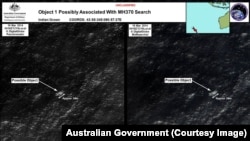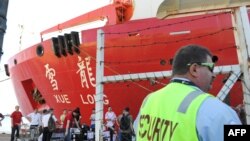BEIJING —
Australia has dispatched search planes for a third consecutive day to search the remote southern Indian Ocean for debris possibly from missing Malaysia Airlines flight 370, now lost for two full weeks.
The international team hunting for the plane returned Saturday to an area about 2,500 kilometers southwest of Perth where an Australian satellite spotted two large objects earlier in the week.
The searches have come up with no sign of wreckage in the area. Australia has cautioned that the objects might have no connection to the Boeing 777, carrying 239 passengers and crew.
Lieutenant Tim McAlevey, a pilot from New Zealand, said he was disappointed but still hopeful searchers would find possible debris from the aircraft that was spotted by a satellite on March 16.
"It's certainly disappointing and I've got every confidence that if there is an object there that we will find it and every time that we launch we hold that hope," he said. "However, we are just going to keep going until we find it.''
Debris may have sunk
Earlier, Australia's Deputy Prime Minister Warren Truss told reporters in Perth it is possible that something floating on the sea that long ago may no longer be floating and may have sunk to the bottom of the Indian Ocean.
Officials say three Australian Air Force P-3 Orions, the U.S. Navy’s P-8 Poseidon, and a long-range corporate jet carrying spotters from the Australian Maritime Safety Authority were involved in the search effort Friday. The planes are flying long trips from Perth to where the objects are believed to be located, more than 2,000 kilometers off shore.
John Young, general manager of the Australian Maritime Safety Authority, says searchers have changed tactics after radar detections failed to turn up anything on Thursday.
"We have re-planned the search to be visual, so aircraft flying relatively low very highly skilled and trained observers looking out of the aircraft windows and looking to see objects, Young explained. "Of its nature, that means that aircraft are spaced more closely together and we will need more aircraft for a search of that type."
Malaysian authorities said three Chinese aircraft and two Japanese P-3 Orion search planes were heading toward the southern corridor search zone. Transportation Minister Hishammuddin Hussein also told reporters in Kuala Lumpur Friday that Britain is sending the survey ship HMS Echo to the southern Indian Ocean. He said Malaysian officials plan to ask the U.S. defense secretary for more specialist search assets, including remotely operated vehicles for underwater salvage.
Hishammuddin said China plans to join the search Saturday, with Japan, Britain and France providing additional assistance. But he said more help is needed.
Chinese fleets
Earlier Friday, officials in Beijing said two fleets were about 4,000 to 5,000 kilometers away from the search area. China's Xinhua news agency says the navy ordered the ships to adjust their search focus and head to the area while continuing their search en route. According to the report, China's ice breaker Xuelong, or Snow Dragon was also joining the search, heading out from Perth.
It is not clear how effective sending ships to the area will be. Earlier this week, the American Navy called back the USS Kidd and its two MH-60R Sea Hawk helicopters. Officials said that with the search area expanding in the Indian Ocean, its sophisticated planes are more suited for the mission.
Expanded search area
At the same time the search effort was expanding in the southern corridor, efforts continue in the Andaman Sea as well as in Kazakhstan, the farthest northern point it is believed the plane could have reached.
Malaysian officials said Kazakhstan has confirmed that it has found no trace of flight MH370. But they say they are awaiting word from Kazakh authorities for permission to stage search efforts in the country.
Passengers' families react
In Beijing, the possibility that debris from the plane could be found weighed heavily on the families of those on board the missing flight. Walking in and out of a conference room at a hotel in Beijing where they can watch press conferences and are briefed by Malaysian airlines officials, many looked full of anxiety and anguish.
While few were speaking with reporters Friday, some have already expressed hope that the debris will turn out to be another false lead. Many are still holding out hope that the plane was hijacked and the possibility that their loved ones may still be alive.
The international team hunting for the plane returned Saturday to an area about 2,500 kilometers southwest of Perth where an Australian satellite spotted two large objects earlier in the week.
The searches have come up with no sign of wreckage in the area. Australia has cautioned that the objects might have no connection to the Boeing 777, carrying 239 passengers and crew.
Lieutenant Tim McAlevey, a pilot from New Zealand, said he was disappointed but still hopeful searchers would find possible debris from the aircraft that was spotted by a satellite on March 16.
"It's certainly disappointing and I've got every confidence that if there is an object there that we will find it and every time that we launch we hold that hope," he said. "However, we are just going to keep going until we find it.''
Debris may have sunk
Earlier, Australia's Deputy Prime Minister Warren Truss told reporters in Perth it is possible that something floating on the sea that long ago may no longer be floating and may have sunk to the bottom of the Indian Ocean.
Officials say three Australian Air Force P-3 Orions, the U.S. Navy’s P-8 Poseidon, and a long-range corporate jet carrying spotters from the Australian Maritime Safety Authority were involved in the search effort Friday. The planes are flying long trips from Perth to where the objects are believed to be located, more than 2,000 kilometers off shore.
John Young, general manager of the Australian Maritime Safety Authority, says searchers have changed tactics after radar detections failed to turn up anything on Thursday.
"We have re-planned the search to be visual, so aircraft flying relatively low very highly skilled and trained observers looking out of the aircraft windows and looking to see objects, Young explained. "Of its nature, that means that aircraft are spaced more closely together and we will need more aircraft for a search of that type."
Malaysian authorities said three Chinese aircraft and two Japanese P-3 Orion search planes were heading toward the southern corridor search zone. Transportation Minister Hishammuddin Hussein also told reporters in Kuala Lumpur Friday that Britain is sending the survey ship HMS Echo to the southern Indian Ocean. He said Malaysian officials plan to ask the U.S. defense secretary for more specialist search assets, including remotely operated vehicles for underwater salvage.
Hishammuddin said China plans to join the search Saturday, with Japan, Britain and France providing additional assistance. But he said more help is needed.
Chinese fleets
Earlier Friday, officials in Beijing said two fleets were about 4,000 to 5,000 kilometers away from the search area. China's Xinhua news agency says the navy ordered the ships to adjust their search focus and head to the area while continuing their search en route. According to the report, China's ice breaker Xuelong, or Snow Dragon was also joining the search, heading out from Perth.
It is not clear how effective sending ships to the area will be. Earlier this week, the American Navy called back the USS Kidd and its two MH-60R Sea Hawk helicopters. Officials said that with the search area expanding in the Indian Ocean, its sophisticated planes are more suited for the mission.
Expanded search area
At the same time the search effort was expanding in the southern corridor, efforts continue in the Andaman Sea as well as in Kazakhstan, the farthest northern point it is believed the plane could have reached.
Malaysian officials said Kazakhstan has confirmed that it has found no trace of flight MH370. But they say they are awaiting word from Kazakh authorities for permission to stage search efforts in the country.
Passengers' families react
In Beijing, the possibility that debris from the plane could be found weighed heavily on the families of those on board the missing flight. Walking in and out of a conference room at a hotel in Beijing where they can watch press conferences and are briefed by Malaysian airlines officials, many looked full of anxiety and anguish.
While few were speaking with reporters Friday, some have already expressed hope that the debris will turn out to be another false lead. Many are still holding out hope that the plane was hijacked and the possibility that their loved ones may still be alive.











